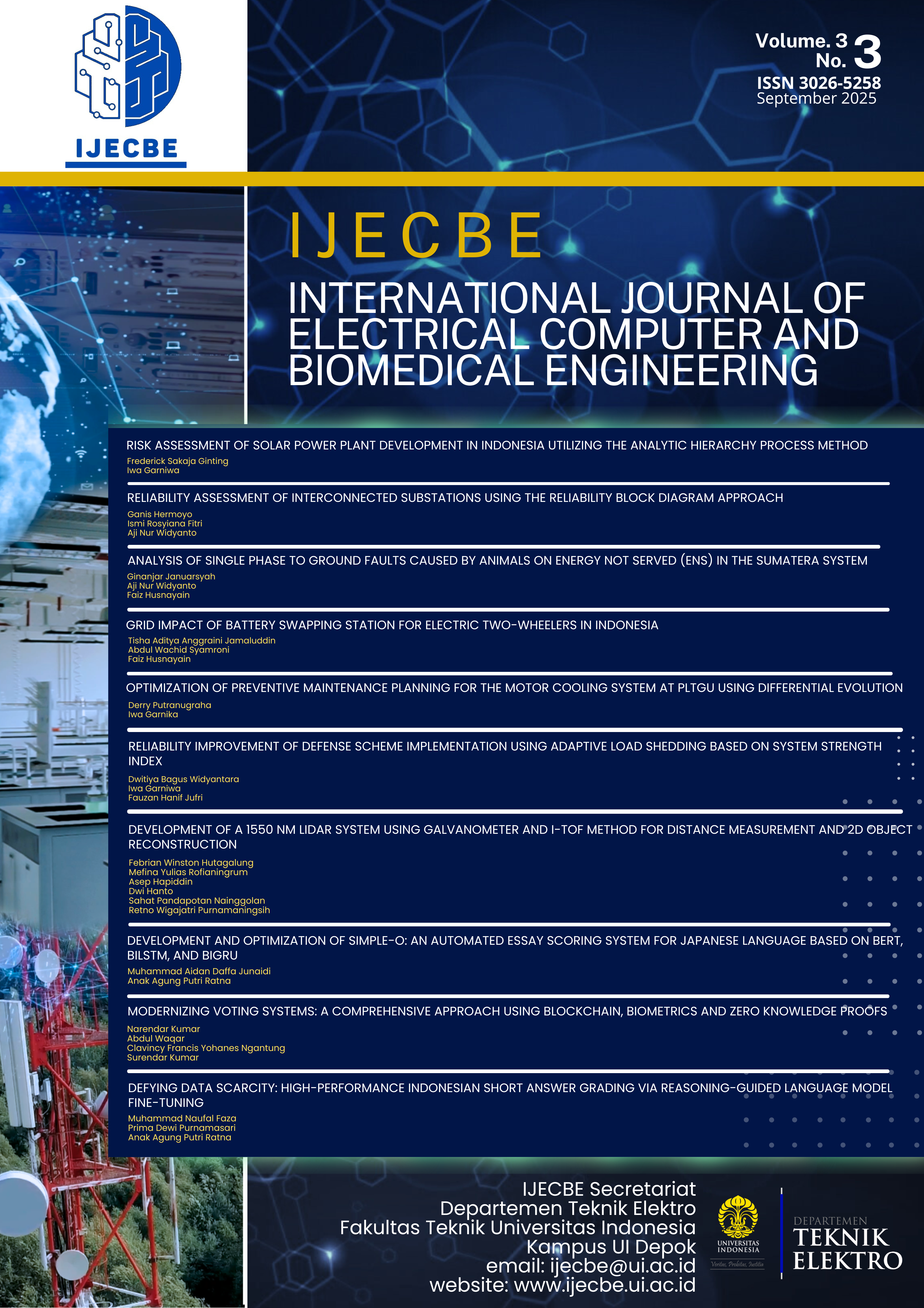Grid Impact of Battery Swapping Station for Electric Two-Wheelers in Indonesia
DOI:
https://doi.org/10.62146/ijecbe.v3i3.130Keywords:
battery swapping station, 2-wheeler electric vehicle, quasi-dynamic power flow, urban distribution grid, multi-source feeders, electric vehicle ecosystemAbstract
Indonesia is rapidly advancing toward electric transportation, with electric two-wheelers playing a crucial role, driven by widespread use and cost-effectiveness. While battery swapping stations (BSS) offer a practical and gap solution over charging station scenario through the stop-go schema, knockdown units and lessen upfront investment, however their unpredictable nature—stemming from random user swaps and varying battery state-of-charge (SoC)—creates dependency operational challenges, particularly for low-voltage distribution grid feeders (DGF). Hence, this article thoroughly evaluates grid impacts using a modified IEEE 9-bus system, focusing on future urban multi-source feeders in Indonesia. A stochastic simulation process for BSS operates every minute over 1440 periods, effectively capturing the near-realistic dynamics of BSS operational behavior and assessing the effects on voltage stability, lines, and transformer loadings concerning BSS integration in quasi-dynamic power flow analysis through DIgSILENT PowerFactory. The findings reveal that even a minor deployment of BSS can cause a voltage drop of up to 1.1%, a 30% increase in transformer loading, and a 100% rise in line loading, especially during peak exchangeable periods. These results highlight the need for proactive infrastructure planning and grid readiness strategies toward Indonesia’s future vision to decarbonize the transport sector into a scalable electric vehicle (EV) ecosystem.
References
Institute for Essential Services Reform (IESR), “Indonesia Energy Transition Outlook 2025,” Institute of Essential Services Reform (IESR), Jakarta, Vol. 5, 2025, Dec. 2024. Accessed: Jun. 28, 2025. [Online]. Available: https://iesr.or.id/wp-content/uploads/2024/12/Indonesia-Energy-Transition-Outlook-2025-Digital-Version.pdf
Sekretariat Jenderal Dewan Energi Nasional, Outlook energi indonesia 2023. Jakarta: Dewan Energi Nasional, 2023. Accessed: Jul. 10, 2024. [Online]. Available: https://den.go.id/publikasi/Outlook-Energi-Indonesia?page=1
E. E. Michaelides, V. N. D. Nguyen, and D. N. Michaelides, “The effect of electric vehicle energy storage on the transition to renewable energy,” Green Energy and Intelligent Transportation, vol. 2, no. 1, p. 100042, Feb. 2023, doi: 10.1016/j.geits.2022.100042.
A. Dall-Orsoletta, P. Ferreira, and G. Gilson Dranka, “Low-carbon technologies and just energy transition: Prospects for electric vehicles,” Energy Conversion and Management: X, vol. 16, p. 100271, Dec. 2022, doi: 10.1016/j.ecmx.2022.100271.
A. D. Setiawan, T. N. Zahari, F. J. Purba, A. O. Moeis, and A. Hidayatno, “Investigating policies on increasing the adoption of electric vehicles in Indonesia,” Journal of Cleaner Production, vol. 380, p. 135097, Dec. 2022, doi: 10.1016/j.jclepro.2022.135097.
A. Kurniasari et al., “A Method Estimating Plug’s Power Usage Pattern for Public Electric Vehicle Charging Stations within Multi-Uncertainty Parameters in Indonesia Urban Area,” Evergreen, vol. 10, no. 3, pp. 1904–1915, Sep. 2023, doi: 10.5109/7151744.
Badan Pusat Statistik, “Jumlah kendaraan bermotor menurut provinsi dan jenis kendaraan (unit), 2023,” Badan Pusat Statistik, Feb. 2024. Accessed: Feb. 04, 2025. [Online]. Available: https://www.bps.go.id/id/statistics-table/3/VjJ3NGRGa3dkRk5MTlU1bVNFOTVVbmQyVURSTVFUMDkjMw==/jumlah-kendaraan-bermotor-menurut-provinsi-dan-jenis-kendaraan-unit-.html?year=2023
S. Abdurrahman, “Outlook 2025: Menanti Perkembangan Infrastruktur Kendaraan Listrik,” TEMPO. Accessed: May 04, 2025. [Online]. Available: https://www.tempo.co/ekonomi/outlook-2025-menanti-perkembangan-infrastruktur-kendaraan-listrik-1196867
I. Wafa, “10 Tantangan Penggunaan Kendaraan Listrik di Indonesia,” GoodStats. Accessed: May 04, 2025. [Online]. Available: https://data.goodstats.id/statistic/10-tantangan-penggunaan-kendaraan-listrik-di-indonesia-8TJEI
I. Veza, M. Z. Asy’ari, M. Idris, V. Epin, I. M. Rizwanul Fattah, and M. Spraggon, “Electric vehicle (EV) and driving towards sustainability: Comparison between EV, HEV, PHEV, and ICE vehicles to achieve net zero emissions by 2050 from EV,” Alexandria Engineering Journal, vol. 82, pp. 459–467, Nov. 2023, doi: 10.1016/j.aej.2023.10.020.
J. Deng, C. Bae, A. Denlinger, and T. Miller, “Electric Vehicles Batteries: Requirements and Challenges,” Joule, vol. 4, no. 3, pp. 511–515, Mar. 2020, doi: 10.1016/j.joule.2020.01.013.
J. Martínez-Gómez and V. S. Espinoza, “Challenges and Opportunities for Electric Vehicle Charging Stations in Latin America,” WEVJ, vol. 15, no. 12, p. 583, Dec. 2024, doi: 10.3390/wevj15120583.
F. Pardo-Bosch, P. Pujadas, C. Morton, and C. Cervera, “Sustainable deployment of an electric vehicle public charging infrastructure network from a city business model perspective,” Sustainable Cities and Society, vol. 71, p. 102957, Aug. 2021, doi: 10.1016/j.scs.2021.102957.
W. G. Suci, “Ketersediaan Charging Station Minim, Tantangan Utama Pengembangan Motor Listrik,” Espos.ID. Accessed: May 04, 2025. [Online]. Available: https://kolom.espos.id/ketersediaan-charging-station-minim-tantangan-utama-pengembangan-motor-listrik-1996864
B. K. Yogatama, “Three reasons why consumers are reluctant to switch to electric vehicles,” Kompas.id. Accessed: May 15, 2025. [Online]. Available: https://www.kompas.id/baca/english/2024/03/27/en-tiga-kendala-yang-membuat-konsumen-enggan-beralih-gunakan-kendaraan-listrik
X. Zhao, X. Li, A. Wang, and J. Fang, “The impact of energy prices on electric vehicle adoption: From a perspective of consumer expectations,” Sustainable Futures, vol. 9, p. 100437, Jun. 2025, doi: 10.1016/j.sftr.2025.100437.
Institute for Essential Services Reform (IESR), “Electric Vehicle Incentive Effectiveness Needs Government Support to Reform Other Policies,” Institute for Essential Services Reform (IESR). Accessed: Jun. 28, 2025. [Online]. Available: https://iesr.or.id/en/electric-vehicle-incentive-effectiveness-needs-government-support-to-reform-other-policies/
A. A. Huda, R. Bridle, and A. Suharsono, “Indonesian Electric Vehicle Boom: A Temporary trend or a long-term vision?,” International Institute for Sustainable Development (IISD). Accessed: Jun. 28, 2025. [Online]. Available: https://www.iisd.org/articles/deep-dive/indonesian-electric-vehicle-boom-temporary-trend-or-long-term-vision
D. F. Hakam and S. Jumayla, “Electric vehicle adoption in Indonesia: Lesson learned from developed and developing countries,” Sustainable Futures, vol. 8, p. 100348, Dec. 2024, doi: 10.1016/j.sftr.2024.100348.
S. R. Revankar and V. N. Kalkhambkar, “Grid integration of battery swapping station: A review,” Journal of Energy Storage, vol. 41, p. 102937, Sep. 2021, doi: 10.1016/j.est.2021.102937.
S. Shao, S. Guo, and X. Qiu, “A Mobile Battery Swapping Service for Electric Vehicles Based on a Battery Swapping Van,” Energies, vol. 10, no. 10, p. 1667, Oct. 2017, doi: 10.3390/en10101667.
W. Zhan, Z. Wang, L. Zhang, P. Liu, D. Cui, and D. G. Dorrell, “A review of siting, sizing, optimal scheduling, and cost-benefit analysis for battery swapping stations,” Energy, vol. 258, p. 124723, Nov. 2022, doi: 10.1016/j.energy.2022.124723.
B. D. Purnamasari, T. A. A. Jamaluddin, H. Halidah, and F. Armansyah, “Cost and benefit battery swapping business model for indonesian electric two-wheeler,” IOP Conf. Ser.: Earth Environ. Sci., vol. 1108, no. 1, p. 012010, Nov. 2022, doi: 10.1088/1755-1315/1108/1/012010.
Electra, “How Long to Charge an Electric Car?,” Electra. Accessed: Jun. 28, 2025. [Online]. Available: https://www.go-electra.com/en/newsroom/how-long-to-charge-an-electric-car/
F. Adegbohun, A. von Jouanne, and K. Lee, “Autonomous Battery Swapping System and Methodologies of Electric Vehicles,” Energies, vol. 12, no. 4, p. 667, Feb. 2019, doi: 10.3390/en12040667.
NIO, “NIO launches Battery as a Service.” Accessed: Jun. 28, 2025. [Online]. Available: https://www.nio.com/news/nio-launches-battery-service
A. D. Setiawan, T. N. Zahari, K. Anderson, A. O. Moeis, and A. Hidayatno, “Examining the effectiveness of policies for developing battery swapping service industry,” Energy Reports, vol. 9, pp. 4682–4700, Dec. 2023, doi: 10.1016/j.egyr.2023.03.121.
A. W. Syamroni, G. P. Dinanta, T. A. A. Jamaluddin, and A. Kurniasari, “Behavioral-alike model-driven for the power demand of battery swapping stations in supporting two and three-wheeled electrification in the new capital city of Indonesia,” IOP Conf. Ser.: Earth Environ. Sci., vol. 1267, no. 1, p. 012076, Dec. 2023, doi: 10.1088/1755-1315/1267/1/012076.
S. B. M. A. and S. M., “Time-series quasi-dynamic load flow analysis with seasonal load variation to resolve energy nexus for a practical distribution network in Puducherry smart grid system incorporating harmonic analysis and mitigation,” Energy Nexus, vol. 11, p. 100234, Sep. 2023, doi: 10.1016/j.nexus.2023.100234.
Downloads
Published
How to Cite
Issue
Section
License
Copyright (c) 2025 International Journal of Electrical, Computer, and Biomedical Engineering

This work is licensed under a Creative Commons Attribution 4.0 International License.






